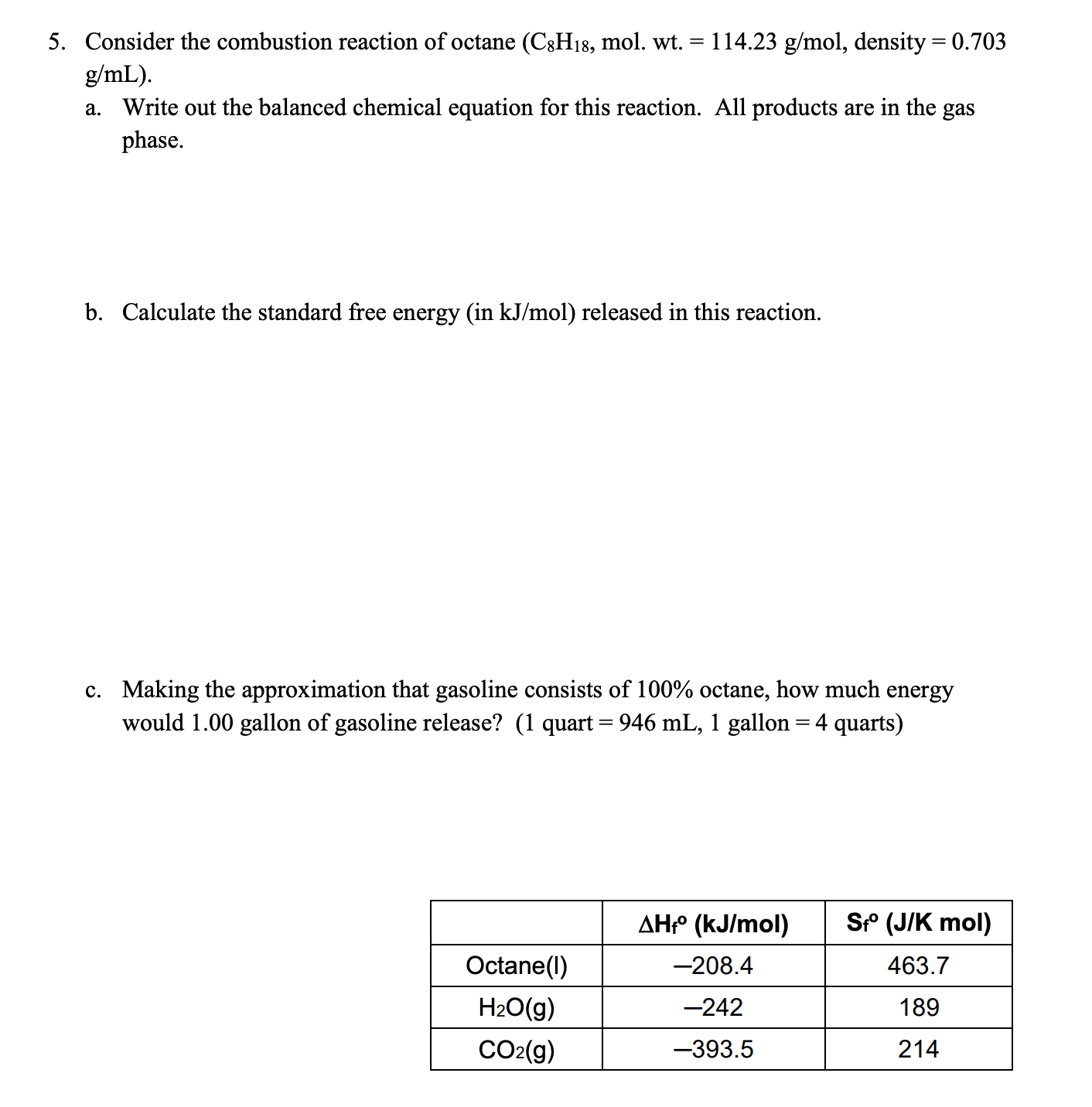5. Consider the combustion reaction of octane (C3H18, mol. wt. =114.23 g/mol, density = 0.703 g/mL). a. Write out the balanced chemical equation for this reaction. All products are in the gas phase. b. Calculate the standard free energy (in kJ/mol) released in this reaction. c. Making the approximation that gasoline consists of 100% octane, how much energy would 1.00 gallon of gasoline release? (1 quart = 946 mL, 1 gallon = 4 quarts) AHº (kJ/mol) Sº (J/K mol) Octane(l) -208.4 463.7 H2O(g) -242 189 CO2(g) -393.5 214
5. Consider the combustion reaction of octane (C3H18, mol. wt. =114.23 g/mol, density = 0.703 g/mL). a. Write out the balanced chemical equation for this reaction. All products are in the gas phase. b. Calculate the standard free energy (in kJ/mol) released in this reaction. c. Making the approximation that gasoline consists of 100% octane, how much energy would 1.00 gallon of gasoline release? (1 quart = 946 mL, 1 gallon = 4 quarts) AHº (kJ/mol) Sº (J/K mol) Octane(l) -208.4 463.7 H2O(g) -242 189 CO2(g) -393.5 214
Chemistry for Engineering Students
4th Edition
ISBN:9781337398909
Author:Lawrence S. Brown, Tom Holme
Publisher:Lawrence S. Brown, Tom Holme
Chapter10: Entropy And The Second Law Of Thermodynamics
Section: Chapter Questions
Problem 10.102PAE: 10.102 Ammonia can react with oxygen gas to form nitrogen dioxide and water. (a) Write a balanced...
Related questions
Question
Please answer question 5A, 5B, and 5C.

Transcribed Image Text:5. Consider the combustion reaction of octane (C3H18, mol. wt. =114.23 g/mol, density = 0.703
g/mL).
a. Write out the balanced chemical equation for this reaction. All products are in the gas
phase.
b. Calculate the standard free energy (in kJ/mol) released in this reaction.
c. Making the approximation that gasoline consists of 100% octane, how much energy
would 1.00 gallon of gasoline release? (1 quart = 946 mL, 1 gallon = 4 quarts)
AHº (kJ/mol)
Sº (J/K mol)
Octane(l)
-208.4
463.7
H2O(g)
-242
189
CO2(g)
-393.5
214
Expert Solution
This question has been solved!
Explore an expertly crafted, step-by-step solution for a thorough understanding of key concepts.
This is a popular solution!
Trending now
This is a popular solution!
Step by step
Solved in 6 steps with 6 images

Knowledge Booster
Learn more about
Need a deep-dive on the concept behind this application? Look no further. Learn more about this topic, chemistry and related others by exploring similar questions and additional content below.Recommended textbooks for you

Chemistry for Engineering Students
Chemistry
ISBN:
9781337398909
Author:
Lawrence S. Brown, Tom Holme
Publisher:
Cengage Learning

Chemistry: The Molecular Science
Chemistry
ISBN:
9781285199047
Author:
John W. Moore, Conrad L. Stanitski
Publisher:
Cengage Learning

Chemistry & Chemical Reactivity
Chemistry
ISBN:
9781133949640
Author:
John C. Kotz, Paul M. Treichel, John Townsend, David Treichel
Publisher:
Cengage Learning

Chemistry for Engineering Students
Chemistry
ISBN:
9781337398909
Author:
Lawrence S. Brown, Tom Holme
Publisher:
Cengage Learning

Chemistry: The Molecular Science
Chemistry
ISBN:
9781285199047
Author:
John W. Moore, Conrad L. Stanitski
Publisher:
Cengage Learning

Chemistry & Chemical Reactivity
Chemistry
ISBN:
9781133949640
Author:
John C. Kotz, Paul M. Treichel, John Townsend, David Treichel
Publisher:
Cengage Learning

Chemistry & Chemical Reactivity
Chemistry
ISBN:
9781337399074
Author:
John C. Kotz, Paul M. Treichel, John Townsend, David Treichel
Publisher:
Cengage Learning

General Chemistry - Standalone book (MindTap Cour…
Chemistry
ISBN:
9781305580343
Author:
Steven D. Gammon, Ebbing, Darrell Ebbing, Steven D., Darrell; Gammon, Darrell Ebbing; Steven D. Gammon, Darrell D.; Gammon, Ebbing; Steven D. Gammon; Darrell
Publisher:
Cengage Learning

Chemistry: An Atoms First Approach
Chemistry
ISBN:
9781305079243
Author:
Steven S. Zumdahl, Susan A. Zumdahl
Publisher:
Cengage Learning